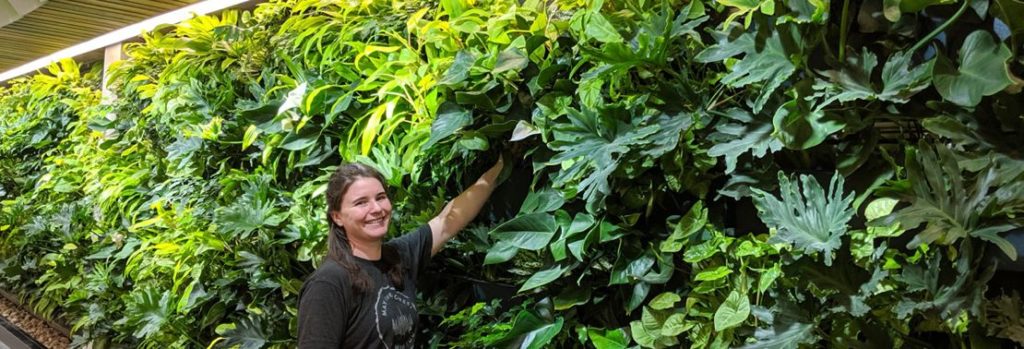Mikaela Wilkes of Stuff.co.nz writes:
Close your eyes and imagine Auckland central. Now put a jungle filter on it: apartment buildings and offices are green instead of grey, and lush native vegetation springs out of every roof and wall. Obsessive millennial houseplant collectors could rejoice in not only filling their flats with plants – their buildings could also be made of plants. Sound cool?
Graham Cleary, founder and CEO of green architecture and landscaping company Natural Habitats thinks so too, and he’s been on a crusade to green up our cities for 30 years.
 A green wall or roof is essentially a panel of vegetation. Where a standard garden is horizontal, a green wall has been flipped on its side. The science is in how you put a garden on its side, make it light enough, and choose resilient plants that won’t outgrow basic maintenance. Natural Habitats uses a recycled polystyrene that mimics soil and incredibly, the plants react to it like soil. The panels of plants are light and can be easily moved and clipped onto a metal structure on the walls of the building.
A green wall or roof is essentially a panel of vegetation. Where a standard garden is horizontal, a green wall has been flipped on its side. The science is in how you put a garden on its side, make it light enough, and choose resilient plants that won’t outgrow basic maintenance. Natural Habitats uses a recycled polystyrene that mimics soil and incredibly, the plants react to it like soil. The panels of plants are light and can be easily moved and clipped onto a metal structure on the walls of the building.
For all you plant nerds, the type used are called epiphytes (perching plants). Epiphytes naturally perch inside other plants and are happy in tight spaces, and growing from heights. Natural Habitats uses natives, philodendrons, astelia, small shrubs from the pohutukawa family and orchids.
“Green walls and roofs contribute to better air quality, reduce city noise and provide a layer of insulation resulting in energy efficiencies. They can keep buildings cooler in summer and warmer in winter”
Graham Cleary
Natural Habitats CEO
“Green walls and roofs contribute to better air quality, reduce city noise and provide a layer of insulation resulting in energy efficiencies. They can keep buildings cooler in summer and warmer in winter,” said Cleary. And they don’t need as much maintenance as you might imagine.
The benefits of green architecture/biophilia
- Mitigates climate change because plants absorb carbon
- Aids climate change adaption because increased urban vegetation lowers urban temperatures and helps to slow storm water flows
- Green walls and roofs are natural air filters. They convert carbon dioxide to oxygen and toxic substances, including those found in modern buildings, are removed from the air
- Remedies biodiversity loss because increased urban vegetation will potentially provide increased habitat for urban wildlife
- Improves human wellbeing because exposure to and interaction with nature has physical and psychological benefits for people. Hospitals built with green architecture have halved the bedtime of their patients and employees in green offices take fewer sick/mental health days.
Read more: What would happen to Auckland if we put a green roof and green wall on every home
 Greenroofs.comConnecting the Planet + Living Architecture
Greenroofs.comConnecting the Planet + Living Architecture








